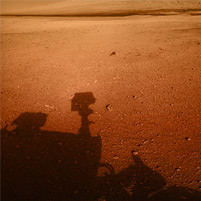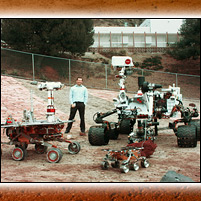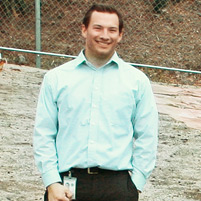The Right Stuff


Mars rovers*

Eric Blood (E'09,'10)
In 2010, Eric Blood (E'09,'10) had earned his master's degree in engineering from Carnegie Mellon University and was already beginning his second assignment at NASA.
Within a year, he was assigned to the Mars rover team. Today, he is one of less than a dozen people to get the first look at images from the surface of Mars.
All because he had the right stuff.
"It's pretty incredible. I never thought I'd have an opportunity like this," said Blood, who first worked at NASA as a summer intern through a fellowship he received while at CMU.
Following graduation he started work at NASA's Jet Propulsion Laboratory in Pasadena, Calif. As part of the rover's engineering operations team, Blood oversees the vehicle's thermal, power, avionics, data management and telecom systems, to name a few.
"The Curiosity rover has a very complex structure," Blood said of the robot, which is about the size of a small SUV with six-wheel drive and the ability to turn in place a full 360 degrees and climb steep hills. "The rover's been designed very well, but we keep a close eye on her as the scientists do their thing with her out there."
Testing has been ongoing for more than six years. Blood has been involved in it for 15 months, from the mobility of the rover's robotic arm to the rover's ability to find the sun and acquire precise rover attitude (roll, pitch and yaw) with respect to the direction of gravity.
"We have a big sand box — a test bed — and we have a twin of the rover. There are about 60 of us on the engineering operations team, and we set up our test rover and do all kinds of major tests with it, operating it in specific ways here on Earth," Blood explained. "Now we will work through Mission Control to start walking Curiosity through those same activities on Mars."
Blood says it's a lot of fun. But like any job of this magnitude, there are many stressors involved.
"It's a high pressure situation. You're dealing with a $2.5 billion vehicle with a very complex infrastructure. You've got to get your job done right the first time. There isn't time to do it twice," he said.
"And you've got to be able to interact well with other team members, and sometimes that's not so easy at the end of a 14-hour shift," added Blood, who recently took on the position of president of the L.A. alumni chapter as he continues his role on the Mars rover team. "Working in teams at CMU and putting in those long nights on projects really prepared me for my work with NASA."
As Curiosity began its descent through the atmosphere around the orange planet, Blood was listening closely to the voices reporting its progress.
"Given the complexity of the system, I was hoping for the best and prepared for the worst," Blood said. But minute after minute they kept hearing good news over the intercom, every step proceeding as planned.
"Entry. Parachute deploy, followed by a report that we were slowing down which meant that the parachute actually worked and didn't blow apart. Heat shield separation and radar acquisition of the ground. Pretty exciting. And finally, touchdown," he said.
And the room filled with high-fives and hugs. Then, as an added bonus, the over-flight from NASA's Odyssey orbiter kept a connection for much longer than expected.
"That meant we received our first images of the planet within minutes of touchdown. There it was. Mars. The first images of Mars from this mission," Blood said. "Every time that I relive the moment, I can't help but smile."
In addition to Blood, CMU has another prominent connection with this mission.
A version of CMU's navigation software will help guide the robot during its mission to determine if Mars ever could have supported life. The software was first developed at CMU's Robotics Institute in 2000 by Tony Stentz, now director of the National Robotics Engineering Center.
CMU's next stop in space? We're shooting for the moon.
*Mars rovers: In the front right is the Sojourner Rover Engineering Model (EM), which landed on the Pathfinder mission in 1998. On the left is the Mars Exploration Rover (MER) EM, otherwise known as Spirit and Opportunity, which landed in 2004. And in the back right is Mars Science Laboratory (MSL) EM, Curiosity, which landed last week.
Related Links: College of Engineering | Dept of Mechanical Engineering | Alumni Association | Robotics Institute | National Robotics Engineering Center
